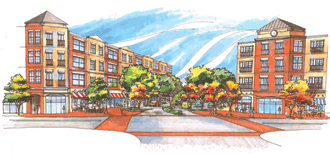A SITE SELECTION EDITORIAL PROFILE
CITY OF MANASSAS PARK, VIRGINIA
CITY OF MANASSAS PARK, VIRGINIA
Park Center: Transit-Oriented Growth
W
hen local and state officials donned their ceremonial hard hats and lifted their ceremonial shovels to break ground on what will become the city's new downtown last May, it was the culmination of years of work, a long-term vision and a few false starts.
Earlier attempts at a public-private partnership to develop the open tract of land across from city hall had fallen flat.
"There was an old elementary school site right smack in the middle of the city that wasn't being used, and it was a significant piece of property that the city owned," recalls Manassas Park City Attorney Dean Crowhurst. In the late 1990s, the city fathers hatched a plan. At the time, the city's crossroads,

"Basically, we were talking about creating a downtown out of nothing," Crowhurst says. City officials were interested in developing a new walkable downtown street grid that would include apartments, offices, city services, restaurants, neighborhood retail and a pedestrian bridge to a new commuter rail system – a bold plan at the time.
But with the office market in a downturn, and before the notion of transit-oriented growth had captured the collective imaginations of metros around the country, few developers expressed interest, even though city officials sweetened the pot by discounting the cost of the land significantly.
City officials revived the project in 2004. In the intervening years, a lot had changed. A regional effort to construct a new Northern Virginia commuter railroad came to fruition, extending the reach of D.C.'s world-class Metrorail system. Northern Virginia emerged as a location of choice for the emerging high-tech industry, as military technology developed by D.C.-rooted defense agencies spawned new business enterprises.
The terrorist attacks of September 11, 2001, set about another wave of change. Federal studies determined that too many government agencies were located within the core of the nation's capital inside the Beltway, making them more susceptible to attack. Studies suggested that moving away from the cheek-by-jowl clusters of street-front office buildings to facilities buffered by deeper set backs and campus-like perimeters would provide additional protection. The FBI, for example, is constructing a 200,000-sq.-ft. (18,580-sq.-m.) state-of-the-art profiling center on a site nearby in Prince William County that meets the new set-back and perimeter requirements.
Interest in the local office market has intensified as a result, driving up the cost of office space in Northern Virginia and causing a migration of the federal workforce – and the contractors that support them – across the Potomac.
Today, Northern Virginia accounts for close to 65 percent of the total number of jobs, and 53 percent of all new jobs, in the entire D.C. metropolitan area, according to Delta Associates. Estimates suggest that Prince William County – including Manassas Park for statistical purposes – will take on an increased percentage of these Northern Virginia jobs, from 14 percent today to 20 percent in 2010.
Enter Clark Realty
Clark, a $2.5-billion privately-held national real estate company, is a major player in implementing the mixed-use, transit-oriented development concept in the region. With more than $1 billion in assets under development and deep experience in the D.C. metro area, the company understands well that not all localities are the same when it comes to business-friendly approaches.
"We saw potential in the Manassas Park project because city officials shared our vision of creating a mixed-use, livable, walkable community," Sotos notes. "The city has also been very reasonable to work with and this is another plus. They are willing to be flexible, while still protecting their own interests."
Echoing comments of local business owners, Sotos notes that the streamlined permitting process allows projects to move forward quickly, compared to other localities. "Many jurisdictions in Northern Virginia take growth for granted, and they add regulation after regulation. At some point, businesses will stop coming because the cost of doing business is just too high." The opposite is true of Manassas Park, he says.
Park Center will form the core of Manassas Park's new downtown. Mere footsteps away from the VRE station, the first phase of development will include 45,000 sq. ft. (4,180 sq. m.) of retail, 274 residential units, and 25,000 sq. ft. (2,322 sq. m.) of flexible commercial/residential space, with a scheduled completion date in fall 2008. When finished, the building designs will incorporate modern styles that remain consistent with a town center image. The façades will combine varying architectural materials and elements to create an urban feel.
In future phases of the project, the company plans to construct additional office space on adjacent acreage.

